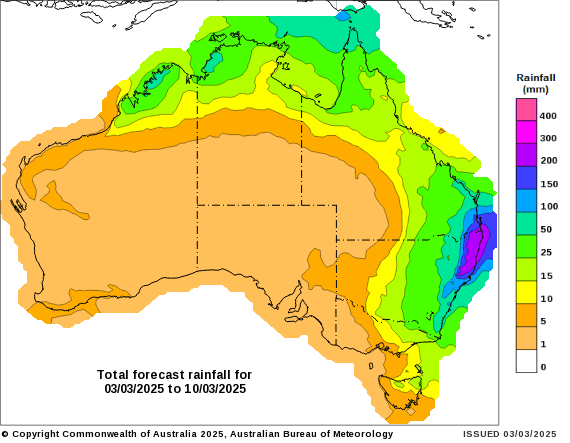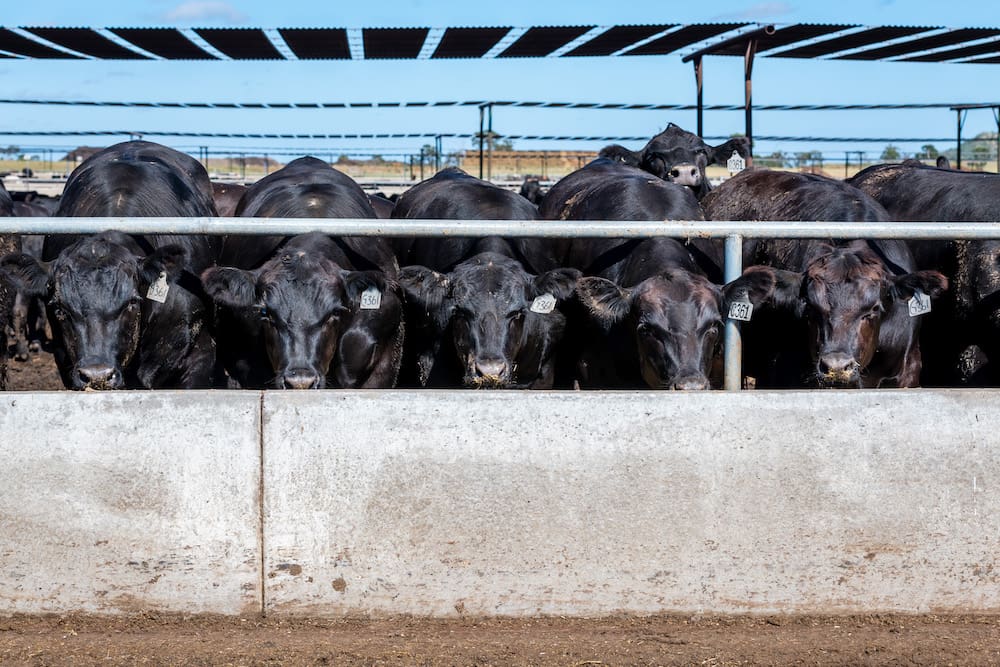THE gap between northern and southern feeder steer prices has narrowed in the past fortnight, with northern grids dropping about 10c.
Weather is still the dominant factor in the market, with warm temperatures being felt across most of the Eastern Seaboard and Cyclone Alfred potentially bringing significant rain at the end of the week.
Feedlot buyers who spoke to Beef Central this morning quoted 400kg+ flatback feeder steers out of the paddock between 370-375c/kg in the north. One quote in the south was slightly dearer at 380c/kg for flatback steers and 390c/kg for British cross. Angus quotes have been ranging between 380c/kg and 410c/kg.
Meat & Livestock Australia’s saleyard-based feeder steer indicator is telling a similar story to the paddock prices, with the gap between the north and the south narrowing.
It closed last week at 359.65c/kg, with the Queensland contribution being 352.21c/kg, NSW 366.53c/kg and Victoria 347.02c/kg. The biggest contributor to the NSW figures was last week’s Wagga Wagga sale.
Demand seems to be relatively soft with at least one large Darling Downs lotfeeder not offering quotes this week and processor contracts for finished 100-day steers delivered in June reportedly booked out. The AuctionsPlus offering of heavy feeders was particularly small, with only 203 head offered at a 45pc clearance and average prices fell 22c/kg.
Beef Central has been told the forward booking has a been a combination of cattle in areas that have had a good season getting to weight quicker than expected and some areas drying out and pushing cattle onto the market. Surface water continues to be in issue in parts of SA and Vic, with some places almost completely destocked.
There is a feeling that the market could see an uptick if Tropical Cyclone Alfred brings significant rain to NSW or Qld in the next fortnight.

The Bureau of Meteorlogy is forecasting significant rain in parts of Queensland and New South Wales with Tropical Cyclone Alfred potentially crossing the coast later this week.
This morning the Bureau of Meteorology had the category two system tracking towards South-East Qld. According to BOM’s eight-day forecast, significant rain is expected on the coast with anywhere between 25-100mm further inland.
US prices continue to make records
Cattle going into 100-day programs will be processed in the back end of the United States barbecue season, which is normally in the middle of summer with the fourth of July Independence Day celebrations being the main day. While beef demand is always fairly strong in the US, it increases in the summer grilling season.
With that in mind, it is worth taking a look at the difference between Australian feeder steer prices and US feeder steer prices.
Last week’s CME feeder futures contract closed at US279c/lb – which converts to AU990c/kg.
To put US prices into perspective, StoneX Australian livestock and commodities manager Ripley Atkinson took a line of 227 feeder steers sold at Oklahoma National Stockyards last week (largest saleyard in the world). They made US2.66c/lb and averaged 818 lbs lwt – which converts to 371kg/head.
Converted to AUD, at an exchange rate of $1AU/$US0.6216, that would be 943c/kg or A$3,500/head.
StoneX cattle swaps trade softer to September
In Australia, forward pricing tool StoneX is has feeder steer prices trading lower out to September – with its mid-mark between bids and offers trading a bit below 360c/kg in September.
Mr Atkinson said bid/offer spreads on active trades typically start at 10c/kg before narrowing as users agree on tradeable prices.
He said liquidity has been increasing since the start of the year with solid interest from both buyers and sellers.

